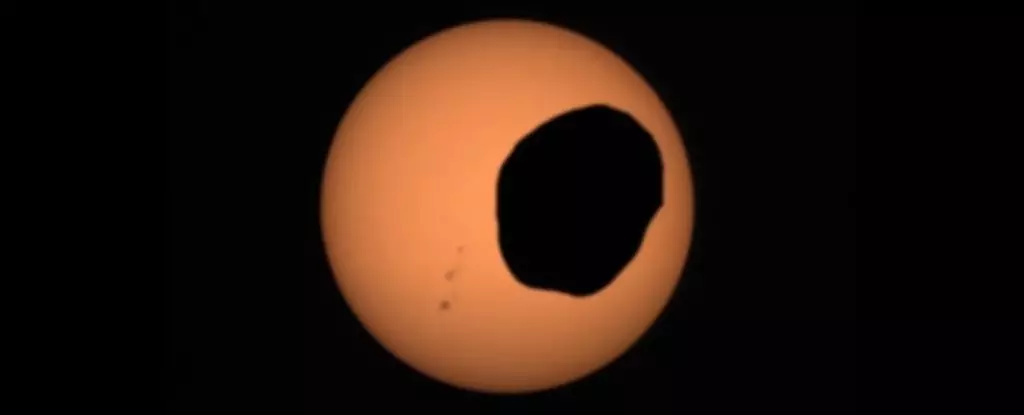The celestial dance between Mars and its two moons, Phobos and Deimos, offers a captivating sight that sets it apart from Earth. While both planets experience moments when their moons cast shadows on their surfaces, the eclipses witnessed on Mars differ significantly from those observed on our home planet. Phobos, named after the ancient Greek word for “fear,” and Deimos, meaning “dread,” complete their orbits around Mars every 7.65 and 30.35 hours, respectively. These relatively short orbital periods contrast with Earth’s moon, which takes approximately 27 days to complete its cycle.
In addition to their swift orbits, Mars’ moons are also distinct in terms of their size and shape. Phobos and Deimos are much smaller compared to our Moon, and their irregular, lumpy structures earned them the endearing nickname “moontatoes.” Unlike the Moon’s round disk that shines beautifully in our night sky, these Martian moonlets lack the perfect symmetry we are accustomed to seeing. Consequently, the events observed on Mars are more accurately described as transits, as they do not entirely block out the Sun’s light. The video captured by NASA’s Perseverance rover provides a stunning example of this phenomenon.
The eclipses on Mars offer more than just visual intrigue; they also have significant scientific implications. During these celestial events, scientists have noticed an unusual effect on the Martian surface caused by the passage of Phobos’ shadow. The Mars InSight lander, an observatory designed to measure seismic activity, experiences a subtle tilt when these transits occur. This slight inclination arises from the surface of Mars slightly deforming due to the reduced solar radiation during the eclipses.
This intriguing phenomenon raises further questions about the planet’s composition and behavior. By studying the impact of Phobos’ shadow on Mars, scientists can gain valuable insights into the planet’s seismic activity and better understand its enigmatic interior. Furthermore, this tilt provides a glimpse into the unique relationship between Mars and its moons, shedding light on the gravitational effects that Phobos exerts on the planet.
When comparing eclipses on Mars to those observed on Earth, an astonishing coincidence becomes apparent. During a total solar eclipse on our planet, the Moon fits perfectly over the Sun’s disk, despite its significantly smaller size. The reason for this lies in the fascinating relationship between the Sun, Moon, and Earth. The Moon’s diameter is approximately 400 times smaller than that of the Sun, and it is coincidentally about 400 times closer to Earth than the Sun. As a result, the Sun and the Moon appear to be roughly the same size in our sky.
However, this alignment can vary slightly due to the slightly elliptical nature of both Earth’s and the Moon’s orbits. These variations give rise to annular eclipses, where the Moon does not completely cover the Sun, creating a beautiful ring of light around the Moon’s disk. The emergence of our species coincided perfectly with these celestial events, allowing us to witness and marvel at these extraordinary moments.
Unfortunately, the Moon’s distance from Earth is gradually increasing over time. It moves away at a rate of about 3.82 centimeters (1.5 inches) per year. In approximately 600 million years, total solar eclipses will no longer be possible on our planet. This serves as a poignant reminder of the fleeting nature of cosmic events and the fortunate timing of our existence.
Just as solar eclipses on Earth provide valuable insights into the Sun, eclipses on Mars offer significant scientific opportunities. By closely observing the motions of Phobos and its gravitational influence on the planet, scientists can gather crucial data to understand Mars’ mysterious interior. These findings not only help map and predict the fate of Phobos but also provide valuable information about the evolution of Mars itself.
As Phobos continues its inching journey closer to Mars, it will eventually reach a point where the planet’s gravity will tear it apart. Scientists believe that this catastrophic event will give rise to a temporary ring of Phobos debris encircling Mars. Tracking the movements of Phobos and Deimos across the Martian sky provides vital information that can aid in predicting the eventual fate of these moons and the planet they orbit.
The eclipses observed on Mars offer us a unique perspective on the cosmic dance between the planet and its moons. These captivating events, although different from Earthly eclipses, provide valuable scientific insights and raise profound questions about the nature of Mars and its future. As we continue to explore the mysteries of the universe, the study of these Martian eclipses will undoubtedly play a pivotal role in expanding our understanding of the cosmos.


Leave a Reply